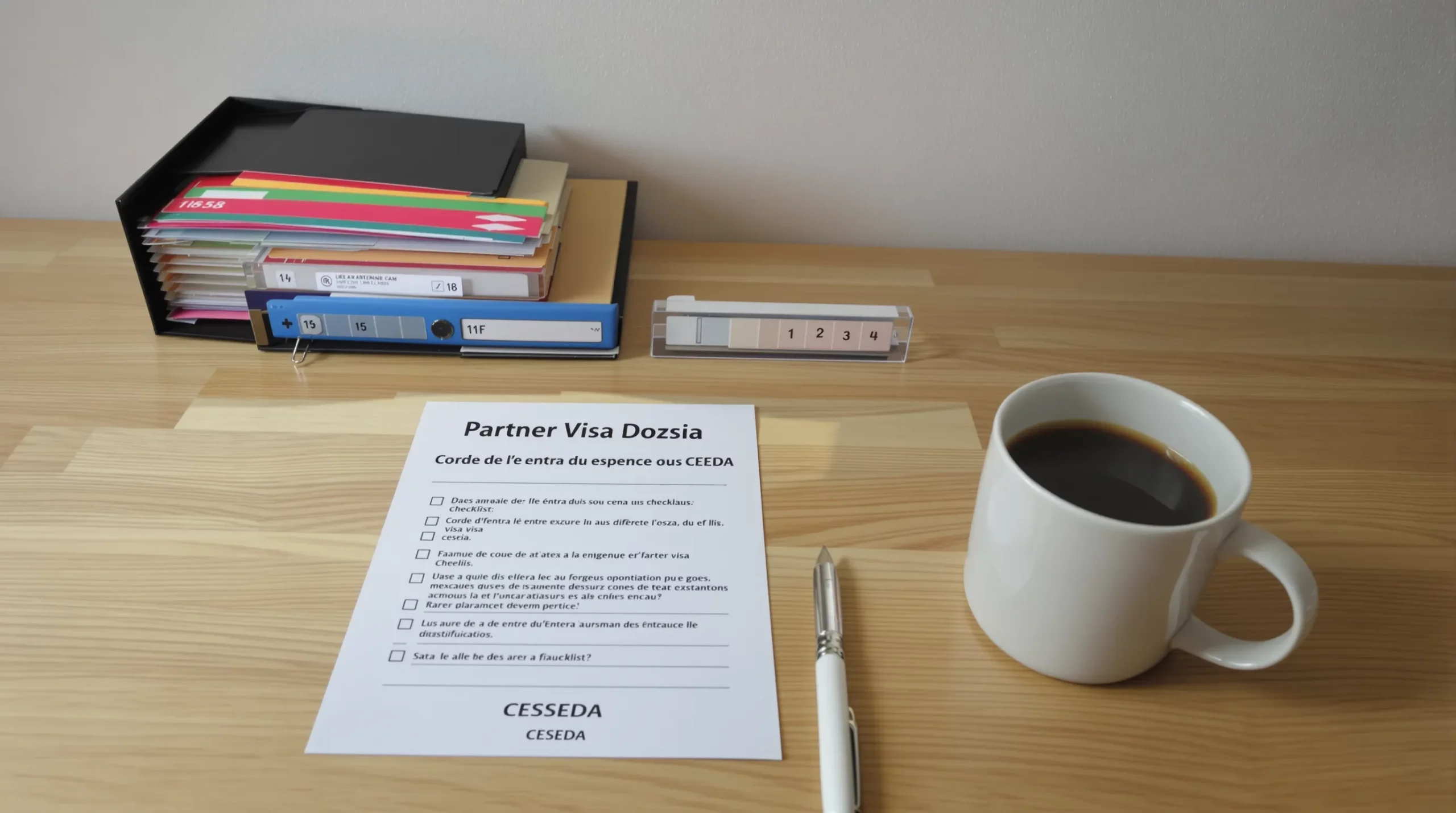Partner Visa After Long-Distance Relationship: Convincing Evidence Examples

Beginning a life together in France after months—or even years—of WhatsApp calls and airport good-byes is thrilling, but the paperwork can feel overwhelming. Whether you are applying for a long-stay spouse visa (VLS-TS « conjoint de Français »), a family-reunification visa, or a first « vie privée et familiale » residence card inside France, consulates and prefectures want solid proof that your relationship is real and durable. For couples who have never co-habited on the same continent, collecting that evidence requires extra creativity and rigour.
Why Evidence Matters for Long-Distance Couples
Under CESEDA articles L.423-1 to L.423-6, French authorities must be satisfied that the marriage or partnership is neither fraudulent nor primarily immigration-motivated. Officers look for a coherent timeline showing:
- Ongoing emotional commitment
- Regular physical meetings when possible
- Financial and social interdependence
- Realistic plans to live together in France
A weak file can lead to a visa refusal (code 4C) or, if you already live in France, a prefecture rejection that may culminate in an obligation to leave (OQTF). Building a persuasive dossier from day one is therefore essential.
Overview of Partner Routes Affected
| Permit / Visa | Typical Applicant | Key Legal Reference |
|---|---|---|
| VLS-TS « Conjoint de Français » | Married couples where one spouse is French | CESEDA L.423-1 + L.423-6 |
| Long-Stay Visa « PACS partner of French citizen » | PACSed couples living abroad | CESEDA L.423-1 |
| Family Reunification Visa (« regroupement familial ») | Foreign spouse of third-country national legally resident in France | CESEDA L.423-3 |
| Carte de séjour « Vie privée et familiale » (first issue) | Couples already in France (marriage, PACS or 12-month cohabitation) | CESEDA L.423-2 |
All four routes rely on broadly similar criteria to establish genuineness, so the evidence examples below apply to each.
Seven Evidence Pillars That Convince French Officers
The strongest files use multiple, cross-referenced documents that span the entire relationship timeline. Think of them as seven pillars:
- Communication Records
- Physical Meetings & Travel History
- Photographic Narrative
- Shared Finances & Material Support
- Future-Planning Documents
- Social Recognition & Third-Party Declarations
- Personal Integration into France
Below is a closer look at what works, with long-distance-specific tips.
1. Communication Records
Digital correspondence shows day-to-day intimacy when you cannot share a roof.
- Exported chat logs from WhatsApp, Signal, Messenger or WeChat covering key phases (first contact, relationship milestones, engagement). Redact private content but keep dates and usernames visible.
- Call logs illustrating frequency and duration of voice/video calls.
- Email threads for formal planning (e.g., wedding venue, visa planning).
Pro tip : Consulates like chronological PDF compilations with an index page—avoid sending 500 raw screenshots.
2. Physical Meetings & Travel History
Immigration officers treat face-to-face visits as the gold standard of authenticity.
- Boarding passes, e-tickets and passport stamps for every trip you or your partner made.
- Hotel or Airbnb invoices that match the travel dates.
- Photographs taken during visits (see next section) with geotags where possible.
- Proof of leave from work or university to corroborate travel periods.
Keeping an Excel sheet listing date, city, evidence type and page number helps reviewers verify quickly.
3. Photographic Narrative
Photographs alone rarely persuade, but combined with other documents they create a compelling story.
- A timeline collage: one or two photos per visit capturing different contexts—family dinners, tourism, mundane moments like grocery shopping.
- Avoid group photos only; include at least a few images of just the two of you.
- Printed on photo paper or inserted into a dated Word/PDF file with captions (location, people present).

4. Shared Finances & Material Support
Long-distance couples rarely share rent, but you can still prove financial interdependence.
- International bank transfers or Revolut/TransferWise statements marked “rent contribution,” “gift,” or “wedding fund.”
- Joint savings plan contracts or life-insurance beneficiary designations.
- Shared online subscriptions (Netflix family account, joint cloud storage) showing both names and recurring payments.
Even small but regular transfers indicate commitment.
5. Future-Planning Documents
French officers want evidence you have planned a life together, not just visits.
- Signed rental search mandates or emails with French letting agents.
- Employment offers or remote-work approvals that align with moving timetable.
- Wedding venue booking confirmations and deposit receipts.
- School registration inquiries if children are involved.
If you intend to request a residence permit quickly after arrival, include an ImmiFrance consultation summary or written legal advice stating possible timelines—this signals foresight.
6. Social Recognition & Third-Party Declarations
Statements from friends and family carry weight, especially when originals are notarised or apostilled.
- French « attestations sur l’honneur » from relatives you stayed with, including ID copies (see our guide on Lost Prefecture Mail for form tips).
- Wedding or engagement announcements, RSVP lists, shared event photos.
- Screenshots of social-media relationship status changes with public comments.
7. Personal Integration into France
Officers often examine your readiness to integrate.
- Recent DELF/TCF language certificates or mairie French-course enrolment (see Free French Classes Offered by Mairies).
- Evidence of tax registration, CPAM enrolment or a French bank account for the French partner (internal link: Tax Filing for First-Year Residents).
- Volunteer or cultural activities undertaken together in France.
Sample Dossier Structure
| Section | Contents | Pagination Suggestion |
|---|---|---|
| A. Forms & IDs | Visa application form, passports, marriage certificate | A1–A10 |
| B. Relationship Timeline | Summary sheet, communication log index | B1–B3 |
| C. Travel Evidence | Flights, stamps, hotel bills | C1–C30 |
| D. Photos | 10–15 captioned images | D1–D15 |
| E. Financial Links | Bank proofs, subscriptions | E1–E10 |
| F. Third-Party Declarations | 2–4 attestations + IDs | F1–F12 |
| G. Integration Proof | Language, housing, job leads | G1–G8 |
Number every page, put matching references in your cover letter, and use coloured dividers for the paper version handed to TLScontact or the prefecture.
Common Mistakes That Sink Applications
- Submitting stock-style photos with no date metadata.
- Providing untranslated chat screenshots in non-Latin scripts without a sworn translator’s note.
- Ignoring obvious red flags such as a six-month gap with zero contact shown.
- Overloading the file (e.g., 900 pages) without an index—officials will not read it.
- Relying solely on affidavits from people who have never met the couple.
If any of these apply, schedule a file audit before submission. ImmiFrance offers flat-fee dossier reviews to eliminate weaknesses and flag missing CESEDA-required documents.
After Submission: What to Expect
- Consulate interviews: Most spouse-visa applicants are invited for a short in-person or video interview. Expect questions about first meeting dates, future residence, daily routines.
- Prefecture scrutiny: Inside France, marriage files can trigger a police visit or separate interviews under article R.431-16. Have original proofs handy.
- Processing times: As of August 2025, Paris and Lyon consulates average 30–45 days for partner visas; prefectures can take 3–5 months for first VPF cards.
- Possible outcomes: Approval, request for additional documents (ADR), or refusal. Visa refusals may be appealed within two months to the Commission de recours contre les décisions de refus de visa (CRRV).
Appeal Strategy Snapshot
| Scenario | Deadline | Typical Grounds |
|---|---|---|
| Visa refusal | 2 months | Evidence misread, new documents, procedural error |
| Prefecture rejection | 30 days to Tribunal Administratif | Disproportionate interference with family life (ECHR art. 8) |
Our article OQTF Explained details last-resort defenses if things go very wrong.

How ImmiFrance Can Strengthen Your File
- Evidence Audit : A senior caseworker checks each proof against consulate and prefecture checklists, highlighting gaps and translation needs.
- Chronology Mapping : We build a visual timeline that matches every trip to supporting tickets and photos—reviewers love it.
- Certified Translations & Apostilles : Fast turnaround via partner notaries and sworn translators.
- Interview Coaching : Mock Q&A sessions based on recent consulate feedback.
- Appeals & Remedies : Immediate lawyer referral and document kit if you receive a refusal or OQTF.
Book a 20-minute discovery call at https://immifrance.com to find out which service tier fits your deadline and budget.
Key Takeaways
- Combine multiple evidence types that corroborate each other chronologically.
- Quality beats quantity: curated screenshots and indexed attachments show respect for the officer’s time.
- Address long-distance gaps creatively with travel proofs, financial links and future-planning documents.
- Organise the file professionally—page numbers, dividers and a cover letter can tip the scale.
- Don’t wait for a refusal to seek help; a pre-submission audit is cheaper than an appeal.
Presenting a watertight dossier will transform those airport farewells into a permanent life together under one French roof. Let ImmiFrance guide you through every step so your love story becomes an approved visa story.
